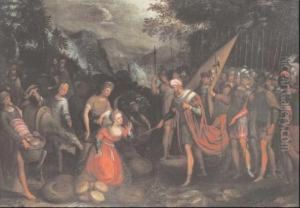Jan Tillens Paintings
Jan Tilius, also known as Jan Tilens or Jan Tiliens, was a Flemish painter active during the early 17th century. He was born in Antwerp in 1589 and is primarily known for his contributions to the Baroque movement, which was characterized by dramatic expression, rich colors, and a dynamic composition.
Jan Tilius was a contemporary of other renowned Flemish artists such as Peter Paul Rubens and Anthony van Dyck, and while he may not have achieved the same level of fame as these artists, his work nonetheless reflects the vibrant artistic environment of the period. He was a member of the Guild of St. Luke in Antwerp, which was an association for painters, sculptors, and other artists. This membership indicates that he was a recognized artist in his own right.
His paintings often depicted religious scenes, landscapes, and genre scenes, following the trends of Flemish Baroque painting. Tilius's work also demonstrates an interest in naturalism and an ability to capture the textures and details of various surfaces, which was a hallmark of Flemish art at the time. He was skilled in creating a sense of depth and atmosphere in his landscapes, which often served as backdrops for his religious and mythological scenes.
Despite his skills and contributions to the Baroque period, Jan Tilius did not leave behind a large body of work, or at least not much has survived to the present day, which makes it difficult to fully assess his impact on the art world. Furthermore, his life and career are not extensively documented, and as such, much about him remains obscure. He passed away in 1630 in Antwerp.
Since Jan Tilius was not as prolific as some of his peers, his works might not be as well-represented in museums and collections. However, those that do exist continue to provide insight into the broader scope of Flemish painting during the Baroque era and help to contextualize the work of the more famous artists of his time.
